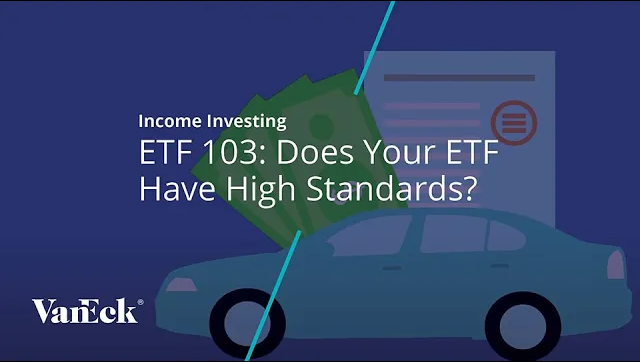ETF 103: Is This ETF Right for Your Portfolio?
September 03, 2019
Read Time 7 MIN
ETF 101: Understanding the Basics
ETF 102: The Inner Workings of ETF Creations and Redemptions
ETF 103: Is This ETF Right for Your Portfolio?
ETF 104: Getting the Most Out of Your ETF Trades
ETF 105: Gain Efficient Access to Bond Markets with Fixed Income ETFs
ETF 106: Debunking Fixed Income Myths
ETF 107: Passive vs. Active ETFs Explained
ETF Evaluation: Looking Under the Hood
Understanding how an ETF is constructed can provide a clearer picture of its exposure. A good place to start is by looking at an ETF’s holdings and the security inclusion process for the index it tracks. A detailed look at the underlying holdings can help investors understand if the fund suits their needs. For example, if an investor is seeking targeted exposure to a specific sector, looking into whether an ETF holds large multinational conglomerates that are involved in a broad array of businesses may factor into whether or not the ETF is the best fit.
To learn more about an ETF’s portfolio construction, investors also should examine two critical attributes: the security inclusion rules of the underlying index,1 which govern what securities the fund should hold; and the fund’s allocations to the selected securities. In particular, it is important to take a closer look at the degree to which the underlying holdings are concentrated or diversified; both approaches have benefits and drawbacks depending on an individual’s risk tolerance and investment goals.
Tracking the Competition
Evaluating an ETF’s performance can include looking at the fund’s performance both on its own and in comparison to peers or an underlying index. Performance over time can provide valuable insights into how the fund has fared under different market conditions. Assessing performance against its peers can provide insights into how similar investments with relatively small differences in security selection processes, exposures, or allocations may react to changes in the market.
Performance can also be measured against its underlying index. Total return difference is a measure of how closely an ETF performs relative to its index. Many factors can influence an ETF’s total return difference, such as the normal operation of a fund, the liquidity of an ETF’s underlying holdings, or a foreign market’s trading hours. For example, a discrepancy may develop between the index returns and the ETF’s net asset value (NAV) if a U.S.-traded ETF holds securities that are traded overseas and one market is open while others are closed.
Evaluating an ETF’s performance can include looking at the fund’s performance both on its own and in comparison to peers or an underlying index.
A small total return difference that is close to the expense ratio is normal, while a large difference beyond that may warrant further investigation. However, keep in mind that total return difference can vary widely from one type of ETF to another. For example, U.S. equity ETFs generally track their indexes relatively tightly, while international ETFs and fixed income ETFs can experience higher tracking discrepancies due to a variety of factors.
ETF Expenses: What It All Costs
The total cost of owning an ETF encompasses:
Fund expenses. Also known as the ETF's expense ratio, is often the only explicit cost investors are able to compare, and can sometimes assume an outsized importance when evaluating ETFs. While low fund expenses can seem like an obvious plus, it is important to remain aware of the kind of performance or exposure that accompanies the low fee. For example, an ultra-low-cost ETF that cannot deliver solid performance or the desired exposure may not be the best choice.
Trading costs. These can include commissions, liquidity, and bid-ask spreads.2
- Commissions are the fees investors pay to buy or sell ETFs—these vary widely depending on the individual brokerage, with some offering commission-free trading for select ETFs.
- The liquidity of the underlying holdings also has a large influence on trading costs, because some securities are more liquid than others. For example, an ETF that holds a basket of extremely liquid large-cap domestic companies will typically have lower bid-ask spreads, and therefore tends to be easier to trade in a cost-effective manner. On the other hand, an ETF that deals in more difficult-to-trade securities such as thinly-traded bonds or foreign equities will tend to experience higher bid-ask spreads and elevated trading costs, which may impact ETF returns.
- Portfolio turnover and rebalancing.3 To remain in line with their respective indexes and ensure their underlying securities are held in the correct proportions, ETFs must periodically rebalance their holdings.4 The more frequently they rebalance, the higher the portfolio turnover. ETFs with higher portfolio turnover may incur elevated trading costs on the underlying securities, which can detract from returns.
- Capital gains. Although ETFs are known for their tax efficiency, some types may still generate tax liabilities for shareholders in the course of their operations. The fund provider’s website should specify whether the ETF has made taxable distributions, and if so, how much.
Key Takeaways
Evaluating ETFs is a critical skill for ETF investors. By taking a closer look at how an ETF delivers exposure and taking the time to understand performance, underlying holdings, and ownership costs, you should be well-equipped to choose the right ETF for your needs.
Follow Us
IMPORTANT DISCLOSURES
1 This applies to passive ETFs. Active ETFs do not track an index, and in such cases it is important to pay especially close attention to the fund prospectus to learn more about the security selection process.
2 Bid-ask spreads: The distance between the “bid” (the amount an investor is willing to pay to buy a security) and the “ask” (the amount an investor is willing to accept to sell a security).
3 Rebalance: The process by which an ETF brings its underlying holdings back into alignment with its index.
4 This does not apply to actively-managed ETFs, which do not track an index.
This is not an offer to buy or sell, or a solicitation of any offer to buy or sell any of the securities mentioned herein. The information presented does not involve the rendering of personalized investment, financial, legal, or tax advice. Certain statements contained herein may constitute projections, forecasts and other forward looking statements, which do not reflect actual results, are valid as of the date of this communication and subject to change without notice. Information provided by third party sources are believed to be reliable and have not been independently verified for accuracy or completeness and cannot be guaranteed. The information herein represents the opinion of the author(s), but not necessarily those of VanEck.
Past performance is not a guarantee of future results. Performance may be lower or higher than performance data quoted. Please visit vaneck.com for performance current to the most recent month end.
Diversification does not assure profit nor protect against loss.
The "Net Asset Value" (NAV) of a VanEck Exchange Traded Fund (ETF) is determined at the close of each business day, and represents the dollar value of one share of the fund; it is calculated by taking the total assets of the fund, subtracting total liabilities, and dividing by the total number of shares outstanding. The NAV is not necessarily the same as the ETF's intraday trading value. VanEck ETF investors should not expect to buy or sell shares at NAV.
ETF Fund shares are not individually redeemable and will be issued and redeemed at their net asset value (NAV) only through certain authorized broker-dealers in large, specified blocks of shares called "creation units" and otherwise can be bought and sold only through exchange trading. Shares may trade at a premium or discount to their NAV in the secondary market. You will incur brokerage expenses when trading Fund shares in the secondary market.
Investing involves substantial risk and high volatility, including possible loss of principal. Bonds and bond funds will decrease in value as interest rates rise. An investor should consider the investment objective, risks, charges and expenses of the Fund carefully before investing. To obtain a prospectus and summary prospectus, which contains this and other information, call 800.826.2333 or visit vaneck.com. Please read the prospectus and summary prospectus carefully before investing.
Related Insights
March 23, 2020
September 27, 2019
Execute ETF trades as cost efficiently as possible by sticking to these important trading best practices.
September 13, 2019
The creation and redemption process is a fundamental feature of the ETF structure. Learn how this process works and its role in driving liquidity and tax efficiency for investors.
August 15, 2019
August 05, 2019
Related Funds
IMPORTANT DISCLOSURES
1 This applies to passive ETFs. Active ETFs do not track an index, and in such cases it is important to pay especially close attention to the fund prospectus to learn more about the security selection process.
2 Bid-ask spreads: The distance between the “bid” (the amount an investor is willing to pay to buy a security) and the “ask” (the amount an investor is willing to accept to sell a security).
3 Rebalance: The process by which an ETF brings its underlying holdings back into alignment with its index.
4 This does not apply to actively-managed ETFs, which do not track an index.
This is not an offer to buy or sell, or a solicitation of any offer to buy or sell any of the securities mentioned herein. The information presented does not involve the rendering of personalized investment, financial, legal, or tax advice. Certain statements contained herein may constitute projections, forecasts and other forward looking statements, which do not reflect actual results, are valid as of the date of this communication and subject to change without notice. Information provided by third party sources are believed to be reliable and have not been independently verified for accuracy or completeness and cannot be guaranteed. The information herein represents the opinion of the author(s), but not necessarily those of VanEck.
Past performance is not a guarantee of future results. Performance may be lower or higher than performance data quoted. Please visit vaneck.com for performance current to the most recent month end.
Diversification does not assure profit nor protect against loss.
The "Net Asset Value" (NAV) of a VanEck Exchange Traded Fund (ETF) is determined at the close of each business day, and represents the dollar value of one share of the fund; it is calculated by taking the total assets of the fund, subtracting total liabilities, and dividing by the total number of shares outstanding. The NAV is not necessarily the same as the ETF's intraday trading value. VanEck ETF investors should not expect to buy or sell shares at NAV.
ETF Fund shares are not individually redeemable and will be issued and redeemed at their net asset value (NAV) only through certain authorized broker-dealers in large, specified blocks of shares called "creation units" and otherwise can be bought and sold only through exchange trading. Shares may trade at a premium or discount to their NAV in the secondary market. You will incur brokerage expenses when trading Fund shares in the secondary market.
Investing involves substantial risk and high volatility, including possible loss of principal. Bonds and bond funds will decrease in value as interest rates rise. An investor should consider the investment objective, risks, charges and expenses of the Fund carefully before investing. To obtain a prospectus and summary prospectus, which contains this and other information, call 800.826.2333 or visit vaneck.com. Please read the prospectus and summary prospectus carefully before investing.
Related Insights
March 23, 2020
September 27, 2019
Execute ETF trades as cost efficiently as possible by sticking to these important trading best practices.
September 13, 2019
The creation and redemption process is a fundamental feature of the ETF structure. Learn how this process works and its role in driving liquidity and tax efficiency for investors.
August 15, 2019
August 05, 2019

